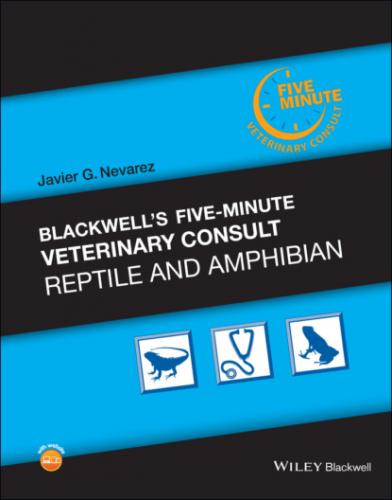Eimeria
DEFINITION/OVERVIEW
Eimeria are apicomplexan parasites characterized by oocytes having four sporocysts that each contain two sporozoites. Eimeria are typically intracytoplasmic parasites, although some have been described as having intranuclear development. They rarely cause disease and commonly form a normal component of the GI flora of reptiles.
ETIOLOGY/PATHOPHYSIOLOGY
Over 200 species of Eimeriahave been described in reptiles and, with the advent of molecular techniques, the rate of species discovery is increasing.
Eimeriahave a direct lifecycle, with infective stages passed in the feces of the host. Eimeriacan be found in the gallbladder, bile ducts, and intestinal epithelium of snakes, lizards, and crocodilians.
Most reports of illness associated with Eimeriainfection are from captive animals that have been housed under suboptimal conditions.
Virulence may be exacerbated by a range of intrinsic and extrinsic factors such as concurrent disease and infective dose.
Disseminated visceral coccidiosis due to an unspecified Eimeriasp. was the cause of death of two of Indo‐Gangetic flap‐shelled turtles (Lissemys punctata andersonii).
An unspecified intranuclear coccidia has been responsible for the deaths of a range of chelonian species but, to date, identification to genus level has not been possible.
SIGNALMENT/HISTORY
Disease usually occurs under circumstances of high stocking density, unsanitary conditions, and maladaptation of wild animals entering captive situations.
CLINICAL PRESENTATION
Most animals are asymptomatic carriers but, when disease occurs, clinical signs are reflective of host‐cell destruction and are dependent on site of infection.
Typically, signs are related to GI disorder and may include anorexia, weight loss, dehydration, diarrhea, and, in severe cases, death.
In cases of disseminated coccidiosis in chelonians, clinical signs may include pneumonia, inner ear infection, pancreatitis, and nephritis.
RISK FACTORS
Husbandry
New (captive or wild) animals entering a collection with poor hygiene and high stocking densities.
Others
Concurrent disease or excessive stress may cause immunosuppression, thus increasing the risks of disease expression.
DIFFERENTIAL DIAGNOSIS
Other GI disease such as bacterial or protozoal infections (i.e., Isospora).
DIAGNOSTICS
Examination of feces for presence of oocysts using light microscopy is the most reliable test.
Molecular techniques such as PCR may aid in species delineation but are unlikely to improve treatment efficacy or prognosis.
Protozoa may also be seen in biopsy or necropsy samples.
For preservation of coccidia for future diagnostics, fecal samples should be stored in 2–3% of aqueous (w/v) K2Cr2O7.
PATHOLOGICAL FINDINGS
Lesions may include proliferation of connective tissue and erosions of epithelial cells lining the intestines, gallbladder, and extra hepatic ducts.
There may also be an accompanying catarrhal or diphtheroid inflammatory response in the small and large intestines of affected animals.
APPROPRIATE HEALTH CARE
N/A
NUTRITIONAL SUPPORT
Ensure that animals are well hydrated, especially if medicating with sulfa drugs.
In cases of anorectic animals, force‐feeding with easily digestible proteins should be initiated.
Some species can have direct feeding by stomach tubing, but placement of an esophagostomy tube should be considered for chronic management.
Supportive fluid therapy should be provided.
CLIENT EDUCATION/HUSBANDRY RECOMMENDATIONS
Remove and isolate sick individuals and reduce stress by providing optimal living conditions and hygiene.
Thoroughly clean the animal’s cage to reduce environmental contamination of oocysts.
Ensure that quarantine protocols have been adopted for all new arrivals; during quarantine, all animals should undergo repeated clinical and fecal examinations.
DRUG(S) OF CHOICE
Because Eimeriaspp. are rarely pathogenic, prophylactic therapy or treatment should not be based on the identification of Eimeriaspp. alone, to avoid development of resistance.
Treatment should only be performed after an Eimeriasp. has been confirmed to be causing clinical disease.
Ponazuril 30 mg/kg PO q48h for 2 treatments, or 30 mg/kg PO q24h for 4 treatments, then repeat for 2–4 treatments 2 weeks apart.
Toltrazuril 15 mg/kg PO q48h for 30 days
Sulfadimethoxine 50 mg/kg q24h for 21 days
Trimethoprim‐sulfa 30 mg/kg daily for 5 days then q48h until the coccidia are eliminated.
PRECAUTIONS/INTERACTIONS
Sulfa drugs are known to be nephrotoxic and care should be taken with their use, particularly in dehydrated or severely compromised individuals.
PATIENT MONITORING
Repeat fecal examination at monthly intervals.
EXPECTED COURSE AND PROGNOSIS
Treatment may have variable efficacy as many protozoa are resistant to a range of anti‐coccidial medication.
Prognosis is good
